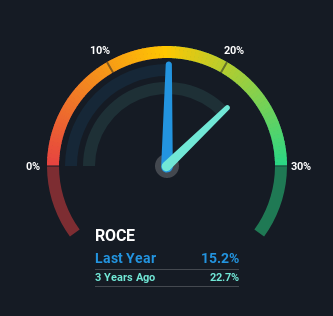- United Kingdom
- /
- Consumer Durables
- /
- LSE:TW.
Taylor Wimpey (LON:TW.) May Have Issues Allocating Its Capital

What trends should we look for it we want to identify stocks that can multiply in value over the long term? One common approach is to try and find a company with returns on capital employed (ROCE) that are increasing, in conjunction with a growing amount of capital employed. Ultimately, this demonstrates that it's a business that is reinvesting profits at increasing rates of return. Having said that, from a first glance at Taylor Wimpey (LON:TW.) we aren't jumping out of our chairs at how returns are trending, but let's have a deeper look.
What is Return On Capital Employed (ROCE)?
For those that aren't sure what ROCE is, it measures the amount of pre-tax profits a company can generate from the capital employed in its business. To calculate this metric for Taylor Wimpey, this is the formula:
Return on Capital Employed = Earnings Before Interest and Tax (EBIT) ÷ (Total Assets - Current Liabilities)
0.15 = UK£764m ÷ (UK£6.2b - UK£1.1b) (Based on the trailing twelve months to July 2021).
Therefore, Taylor Wimpey has an ROCE of 15%. In absolute terms, that's a satisfactory return, but compared to the Consumer Durables industry average of 10% it's much better.
View our latest analysis for Taylor Wimpey

In the above chart we have measured Taylor Wimpey's prior ROCE against its prior performance, but the future is arguably more important. If you'd like to see what analysts are forecasting going forward, you should check out our free report for Taylor Wimpey.
What The Trend Of ROCE Can Tell Us
On the surface, the trend of ROCE at Taylor Wimpey doesn't inspire confidence. Around five years ago the returns on capital were 19%, but since then they've fallen to 15%. Although, given both revenue and the amount of assets employed in the business have increased, it could suggest the company is investing in growth, and the extra capital has led to a short-term reduction in ROCE. If these investments prove successful, this can bode very well for long term stock performance.
On a side note, Taylor Wimpey has done well to pay down its current liabilities to 18% of total assets. So we could link some of this to the decrease in ROCE. Effectively this means their suppliers or short-term creditors are funding less of the business, which reduces some elements of risk. Some would claim this reduces the business' efficiency at generating ROCE since it is now funding more of the operations with its own money.
The Bottom Line
In summary, despite lower returns in the short term, we're encouraged to see that Taylor Wimpey is reinvesting for growth and has higher sales as a result. These trends are starting to be recognized by investors since the stock has delivered a 40% gain to shareholders who've held over the last five years. Therefore we'd recommend looking further into this stock to confirm if it has the makings of a good investment.
On a separate note, we've found 2 warning signs for Taylor Wimpey you'll probably want to know about.
While Taylor Wimpey may not currently earn the highest returns, we've compiled a list of companies that currently earn more than 25% return on equity. Check out this free list here.
If you're looking to trade Taylor Wimpey, open an account with the lowest-cost platform trusted by professionals, Interactive Brokers.
With clients in over 200 countries and territories, and access to 160 markets, IBKR lets you trade stocks, options, futures, forex, bonds and funds from a single integrated account.
Enjoy no hidden fees, no account minimums, and FX conversion rates as low as 0.03%, far better than what most brokers offer.
Sponsored ContentValuation is complex, but we're here to simplify it.
Discover if Taylor Wimpey might be undervalued or overvalued with our detailed analysis, featuring fair value estimates, potential risks, dividends, insider trades, and its financial condition.
Access Free AnalysisThis article by Simply Wall St is general in nature. We provide commentary based on historical data and analyst forecasts only using an unbiased methodology and our articles are not intended to be financial advice. It does not constitute a recommendation to buy or sell any stock, and does not take account of your objectives, or your financial situation. We aim to bring you long-term focused analysis driven by fundamental data. Note that our analysis may not factor in the latest price-sensitive company announcements or qualitative material. Simply Wall St has no position in any stocks mentioned.
Have feedback on this article? Concerned about the content? Get in touch with us directly. Alternatively, email editorial-team (at) simplywallst.com.
About LSE:TW.
Flawless balance sheet and undervalued.


